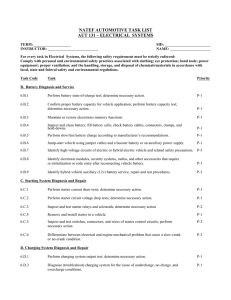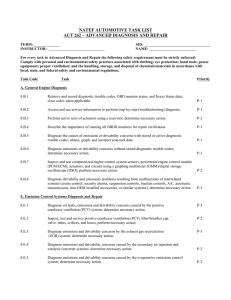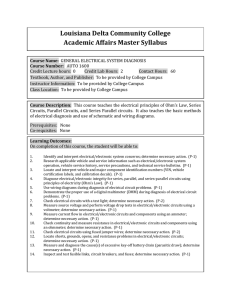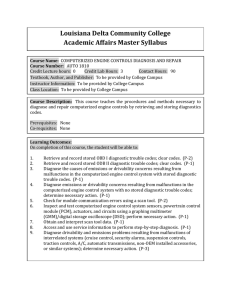2008 Automobile NATEF Electrical/Electronic Systems Task List
advertisement
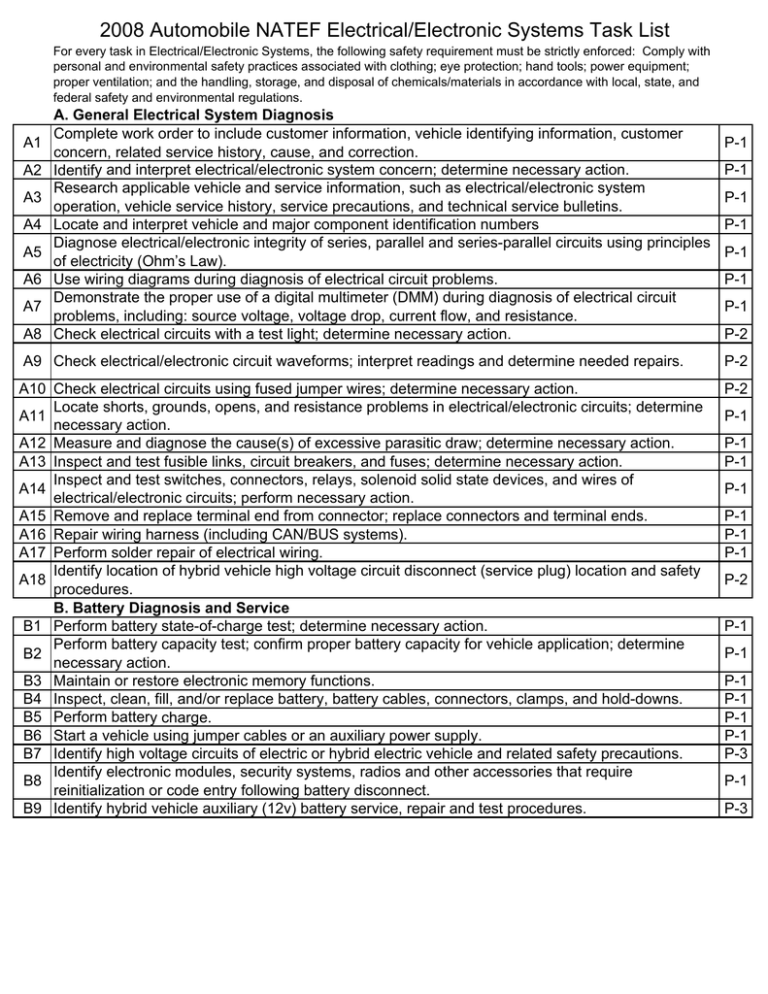
2008 Automobile NATEF Electrical/Electronic Systems Task List For every task in Electrical/Electronic Systems, the following safety requirement must be strictly enforced: Comply with personal and environmental safety practices associated with clothing; eye protection; hand tools; power equipment; proper ventilation; and the handling, storage, and disposal of chemicals/materials in accordance with local, state, and federal safety and environmental regulations. A1 A2 A3 A4 A5 A6 A7 A8 A. General Electrical System Diagnosis Complete work order to include customer information, vehicle identifying information, customer concern, related service history, cause, and correction. Identify and interpret electrical/electronic system concern; determine necessary action. Research applicable vehicle and service information, such as electrical/electronic system operation, vehicle service history, service precautions, and technical service bulletins. Locate and interpret vehicle and major component identification numbers Diagnose electrical/electronic integrity of series, parallel and series-parallel circuits using principles of electricity (Ohm’s Law). Use wiring diagrams during diagnosis of electrical circuit problems. Demonstrate the proper use of a digital multimeter (DMM) during diagnosis of electrical circuit problems, including: source voltage, voltage drop, current flow, and resistance. Check electrical circuits with a test light; determine necessary action. P-1 P-1 P-1 P-1 P-1 P-1 P-1 P-2 A9 Check electrical/electronic circuit waveforms; interpret readings and determine needed repairs. P-2 A10 Check electrical circuits using fused jumper wires; determine necessary action. Locate shorts, grounds, opens, and resistance problems in electrical/electronic circuits; determine A11 necessary action. A12 Measure and diagnose the cause(s) of excessive parasitic draw; determine necessary action. A13 Inspect and test fusible links, circuit breakers, and fuses; determine necessary action. Inspect and test switches, connectors, relays, solenoid solid state devices, and wires of A14 electrical/electronic circuits; perform necessary action. A15 Remove and replace terminal end from connector; replace connectors and terminal ends. A16 Repair wiring harness (including CAN/BUS systems). A17 Perform solder repair of electrical wiring. Identify location of hybrid vehicle high voltage circuit disconnect (service plug) location and safety A18 procedures. B. Battery Diagnosis and Service B1 Perform battery state-of-charge test; determine necessary action. Perform battery capacity test; confirm proper battery capacity for vehicle application; determine B2 necessary action. B3 Maintain or restore electronic memory functions. B4 Inspect, clean, fill, and/or replace battery, battery cables, connectors, clamps, and hold-downs. B5 Perform battery charge. B6 Start a vehicle using jumper cables or an auxiliary power supply. B7 Identify high voltage circuits of electric or hybrid electric vehicle and related safety precautions. Identify electronic modules, security systems, radios and other accessories that require B8 reinitialization or code entry following battery disconnect. B9 Identify hybrid vehicle auxiliary (12v) battery service, repair and test procedures. P-2 P-1 P-1 P-1 P-1 P-1 P-1 P-1 P-2 P-1 P-1 P-1 P-1 P-1 P-1 P-3 P-1 P-3 C1 C2 C3 C4 C5 C6 D1 D2 D3 D4 D5 E1 E2 E3 C. Starting System Diagnosis and Repair Perform starter current draw tests; determine necessary action. Perform starter circuit voltage drop tests; determine necessary action. Inspect and test starter relays and solenoids; determine necessary action. Remove and install starter in a vehicle. Inspect-test switches, connectors, and wires of starter control circuits; perform necessary action. Differentiate between electrical and engine mechanical problems that cause a slow-crank or no-crank condition. D. Charging System Diagnosis and Repair Perform charging system output test; determine necessary action. Diagnose charging system for the cause of undercharge, no-charge, and overcharge conditions. Inspect, adjust, or replace generator (alternator) drive belts, pulleys, and tensioners; check pulley and belt alignment. Remove, inspect, and install generator (alternator). Perform charging circuit voltage drop tests; determine necessary action. E. Lighting Systems Diagnosis and Repair Diagnose the cause of brighter than normal, intermittent, dim, or no light operation; determine necessary action. Inspect, replace, and aim headlights and bulbs. Inspect and diagnose incorrect turn signal or hazard light operation; perform necessary action. E4 Identify system voltage and safety precautions associated with high intensity discharge headlights. F1 F2 F3 F4 G1 G2 G3 H1 H2 H3 H4 H5 H6 H7 H8 H9 H10 H11 H12 H13 F. Gauges, Warning Devices, and Driver Information Systems Diagnosis and Repair Inspect and test gauges and gauge sending units for cause of abnormal gauge readings; determine necessary action. Inspect and test connectors, wires, and printed circuit boards of gauge circuits; determine necessary action. Diagnose the cause of incorrect operation of warning devices and other driver information systems; determine necessary action. Inspect and test sensors, connectors, and wires of electronic (digital) instrument circuits; determine necessary action. G. Horn and Wiper/Washer Diagnosis and Repair Diagnose incorrect horn operation; perform necessary action. Diagnose incorrect wiper operation; diagnose wiper speed control and park problems; perform necessary action. Diagnose incorrect washer operation; perform necessary action. H. Accessories Diagnosis and Repair Diagnose incorrect operation of motor-driven accessory circuits; determine necessary action. Diagnose incorrect heated glass, mirror, or seat operation; determine necessary action. Diagnose incorrect electric lock operation (including remote keyless entry); determine necessary action. Diagnose incorrect operation of cruise control systems; determine necessary action. Diagnose supplemental restraint system (SRS) concerns; determine necessary action. Disarm and enable the airbag system for vehicle service. Diagnose radio static and weak, intermittent, or no radio reception; determine necessary action. Remove and reinstall door panel. Diagnose body electronic system circuits using a scan tool; determine necessary action. Check for module communication (including CAN/BUS systems) errors using a scan tool. Diagnose the cause of false, intermittent, or no operation of anti-theft systems. Describe the operation of keyless entry/remote-start systems. Perform software transfers, software updates, or flash reprogramming on electronic modules. P-1 P-1 P-2 P-1 P-2 P-2 P-1 P-1 P-1 P-1 P-1 P-1 P-2 P-2 P-2 P-1 P-3 P-1 P-3 P-1 P-1 P-2 P-1 P-3 P-1 P-3 P-1 P-1 P-3 P-1 P-2 P-2 P-3 P-3 P-3


